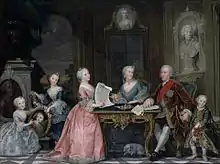Piotr Chernyshev
Count Piotr Grigoryevich Chernyshev (Russian: Граф Пётр Григорьевич Чернышёв; 24 March 1712 – 20 August 1773) was a Russian Imperial nobleman, diplomat, privy counsellor, chamberlain, and senator.

Early life
A member of the Chernyshyov family, he was the son of Grigory Chernyshev (1672–1745) and Avdotya Rzhevskaya (1693–1747).[1] Among his siblings were mayor of Moscow, Count Zakhar Chernyshev and Imperial Russian Field Marshal and General Admiral Count Ivan Chernyshyov.[2]
His father was a close friend of Peter the Great, who was also Piotr's godfather.[3]
Career
Piotr enlisted in the Preobrazhensky Regiment as a child and from 1722 to 1727 served under the young Charles Frederick, Duke of Holstein-Gottorp (1700-1739) as a page, Kammerpage and finally lieutenant-captain.[4] In 1741, during the reign of Empress Anna of Russia, he was made ambassador extraordinary to Denmark and soon afterwards ambassador extraordinary to the Kingdom of Prussia, then ruled by Frederick the Great.[5]
Next, in 1746, he was posted to London, assisting at the Congress of Aix-la-Chapelle at the end of the War of the Austrian Succession between April and October 1748. He helped edit the treaty between Louis XIV and the maritime powers that resulted from the Congress, signed on 18 October 1748 - it settled the succession question and maritime questions and was recognised by Silesia and Prussia.[5]
Personal life
Count Chernyshev married Ekaterina Chernysheva (1715–1779), the daughter of Andrey Ushakov and married the diplomat count Peter Chernyshev, Russian Ambassador to Denmark, Prussia, England and France. Ekaterina was maid of honour to Empress Anna of Russia, as well as favourite and confidante of Anna Leopoldovna. Together, they were the parents of:[6]
- Countess Darya Petrovna Chernyshyova (1739–1802), a friend of the French painter Élisabeth Vigée Le Brun; she married Field Marshal Count Ivan Petrovich Saltykov in 1769.[7]
- Countess Natalya Petrovna Chernyshyova (1741–1837), inspiration for Pushkin's The Queen of Spades; she married Prince Vladimir Borisovich Golitsyn in 1766.[8][9]
Count Chernyshev died of dropsy in Saint Petersburg and was buried at the Alexander Nevsky Lavra in the Lazarevskoe Cemetery.[10] His tomb inscription reads "His life was cut short by multiplying diseases, to the extreme sorrow of his neighbours and to the sincere grief of his friends and admirers". The later historian Pyotr Vladimirovich Dolgorukov wrote that "He was an intelligent and talented man, but immensely arrogant, unusually vain and intolerably arrogant; nobody loved him."[11]
References
- Rounding, Virginia (22 January 2008). Catherine the Great: Love, Sex, and Power. Macmillan. p. 39. ISBN 978-0-312-37863-9. Retrieved 7 April 2023.
- Kistler, Charles E. (1946). British Diplomacy and Russia During the Seven Years' Wars. University of Michigan. Retrieved 7 April 2023.
- Popov, Aleksandr (2018). Два Петербурга. Мистический путеводитель (in Russian). Litres. ISBN 9785457431782.
- "Portrait of Princess Natalia Golitsyna". Hermitage Museum. Retrieved 17 April 2019.
- Solovyov, Sergei Mikhailovich (1976). History of Russia: A new empress: Peter III and Catherine II, 1761-1762. Academic International Press. ISBN 978-0-87569-066-7. Retrieved 7 April 2023.
- FitzLyon, Kyril; Zinovieff, Kyril; Hughes, Jenny (2003). The Companion Guide to St Petersburg. Companion Guides. p. 380. ISBN 978-1-900639-40-8. Retrieved 7 April 2023.
- Pchelov, Evgeniy Vladimirovich (2001). Рюриковичи. История династии (in Russian). ОЛМА Медиа Групп. p. 222. ISBN 9785224031603.
- "Княгиня Наталья Петровна Голицына" (in Russian). aleksandr-suvorov.ru. Retrieved 19 April 2019.
- Petrova, Elena (3 December 2015). "Тайны Пиковой дамы. Как Голицына стала прообразом пушкинской героини" (in Russian). spb.aif.ru. Retrieved 19 April 2019.
- "Entry on www.lavraspb.ru" (in Russian).
- (in Russian) Записки князя Петра Долгорукова. — СПб, 2007.- 604 с.
